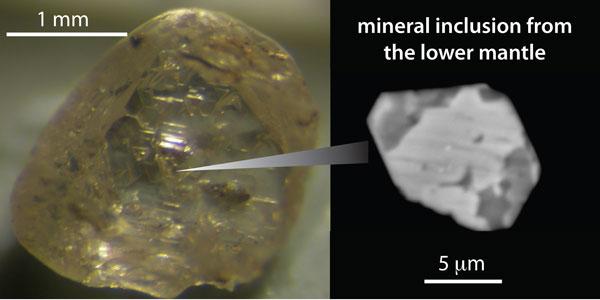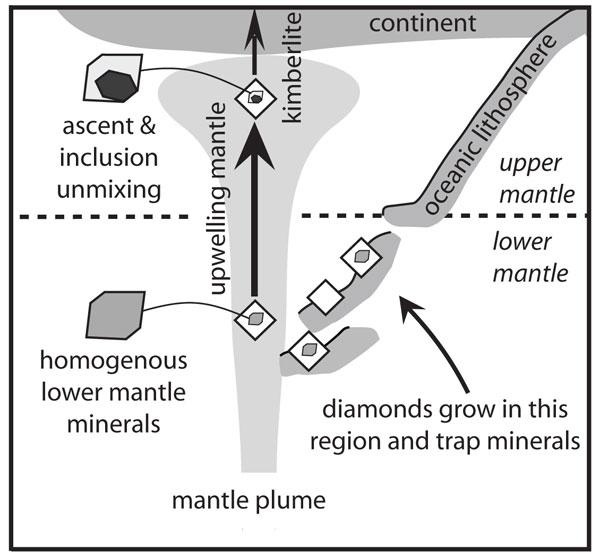'Superdeep' Diamonds Hint at Depth of Carbon Cycle


Diamonds from deep underground now reveal that the activities of life can have effects far beneath Earth's surface, researchers find.
All life on Earth is based on carbon. This element moves through the atmosphere, oceans and the planet's crust in a pattern called the carbon cycle. Humans and other life on Earth are part of this cycle — for instance, we and other species live off nutrients made with carbon, such as sugars, fats and proteins, and also exhale carbon dioxide and emit the gas with our cars and factories.
The most well-known parts of the carbon cycle occur at or near the Earth's surface, but recent studies have hinted the carbon cycle might extend much deeper into the Earth's interior than is generally thought. For instance, oceanic crust loaded with carbon-rich sediment could delve, or subduct, to mix with the upper mantle layer of hot rock that reaches about 410 miles (660 kilometers) down, or even to the lower mantle below that. If true, more than just Earth's thin crust might play a role in this key cycle — a much larger fraction of the planet might be involved as well.
However, proof that such cycling occurs has proven difficult to come by.
Now "superdeep" diamonds from Brazil reveal the carbon cycle does indeed reach deep into the mantle.
Deep, deep diamonds
Scientists investigated six diamonds from the Juina kimberlite field in Brazil. Most diamonds excavated from the Earth's surface formed at depths of less than 125 miles (200 km), but others, such as the Juina diamonds, have yielded rare, superdeep diamonds. These diamonds can hold tiny mineral grains called inclusions, whose chemistry bespeaks of origins at much greater depths. [Related: How Are Diamonds Made?]
Get the world’s most fascinating discoveries delivered straight to your inbox.
"Inclusions in diamonds are fantastically useful for studying the inaccessible part of the deep Earth," said researcher Michael Walter, a geologist at the University of Bristol in England. "It's a bit like studying extinct insects in amber. Although we can't extract DNA and grow dinosaurs, we can extract their chemical compositions and tell where they formed by growing minerals in the lab at extreme conditions."
After the researchers analyzed the inclusions — each just 15 to 40 microns wide, or one-sixth to two-fifths of the diameter of a human hair — they found the inclusions contained the entire range of minerals one would expect of a volcanic rock called basalt that originally formed at the planet's surface and then crystallized under extreme high pressures and temperatures. Those conditions to form the inclusions would only be found at depths greater than 435 miles (700 km) in the lower mantle, suggesting the material cycled from the surface down to the Earth's interior.
The team found that the diamonds also hold carbon isotopes that apparently originated near the surface. All carbon atoms have six protons, but isotopes of carbon each have differing numbers of neutrons in their nuclei — for instance, carbon-12 has six neutrons, while carbon-13 has seven — and the diamonds possessed relatively low levels of carbon-13, suggesting an origin in the crust, not the mantle.
"Carbon originating in a rock called basalt, which forms from lava at the surface, is often different from that which originates in the mantle, in containing relatively less carbon-13," explained researcher Steve Shirey at the Carnegie Institution in Washington. "These superdeep diamonds contained much less carbon-13, which is most consistent with an origin in the organic component found in altered oceanic crust."
The researchers suggest these diamonds crystallized when diamond-forming fluids that originated in basalt from ocean crust subducted into the lower mantle.
Resurfacing
After the diamonds formed in the lower mantle, they may have then been launched back near the surface by a giant plume of hot rock originating from near Earth's core known as a mantle plume, possibly starting back during the Cretaceous era, when dinosaurs still ruled the world.
It may be that "the major carbon repository in Earth is probably the mantle, rather than the atmosphere or biosphere, but it is the least well understood," Walter told OurAmazingPlanet. "The mantle reservoir might affect the global cycle over Earth's history."
The scientists detailed their findings in the journal Science online Sept. 15.
This story was provided by OurAmazingPlanet, a sister site to LiveScience.





